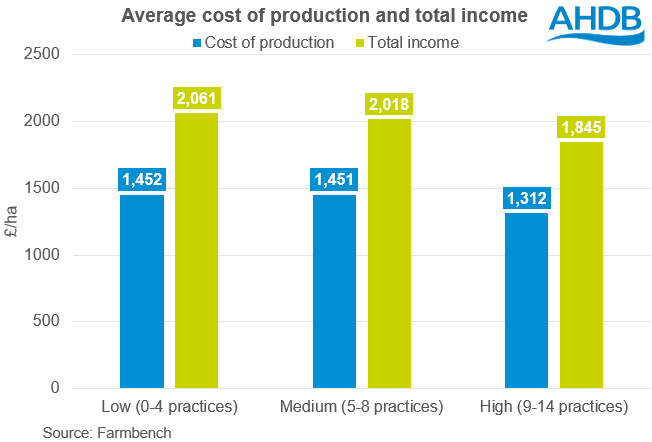
Posted on October, 9, 2024 at 09:59 am
Regenerative farming practices are increasingly popular within the UK, with the claimed benefits ranging from soil health to improved profits. As outlined in the previous article, systems using more regenerative practices on average had the lowest cost of production, making key cost savings in fertiliser, labour and machinery use. Within this article we will see how this affects production and as such, profitability.
There are 241 harvest 2023 winter wheat enterprises recorded in this analysis, including milling and feed varieties.
Each farm was asked which of fifteen practices they carried out (shown below) and split into the following groups: ‘High’ (9-14 practices), ‘Medium’ (5-8 practices), and ‘Low’ (0-4 practices).
The ‘high’ group’s (9-14 practices) average crop output was £212/ha less than the ‘low’ group (0-4 practices). While this was partly because they sold their wheat for a lower price, it was also due to lower yields. As each group carried out more practices, the average yield dropped, as seen in Figure 1. The ‘low’ group produced on average 9.34t/ha of winter wheat, in comparison to 8.84t/ha in the ‘high’ group.
The data can’t tell us whether the practices used on farm caused the lower yield, or if the ‘high’ group were originally less productive farms. If the latter, this seems to have been an effective way to reduce spend in line with possible productivity of the farm. While the ‘high’ group had the lowest yield, they still had the lowest cost of production per tonne (£148/t). This was £7-10/t lower than the ‘low’ and ‘medium’ groups, respectively.

Despite a low cost of production, the lower income impacted the profitability. The ‘high’ group average profit was £533/ha, compared to £609/ha in the ‘low’ group. Though making £77/ha less profit, the English farms in the ‘high’ group could access further options under the SFI. For example, a farm in the ‘high’ group could boost profit by £118/ha using two 2024 options: no insecticide use and no tillage. In this scenario, this would make the ‘high’ group the most profitable, with the lowest input costs.

On average each group was profitable, though increased use of regenerative practices does seem to have a financial effect. A lower cost of production benefits the system, but with lower average yields there is still pressure on profitability, looking to harvest 2024 and onwards. The Sustainable Farming Incentive offers English farmers a chance to top up these margins and potentially mitigate risk, when selected carefully, as seen in AHDB’s SFI Stacking analysis.
Source: AHDB